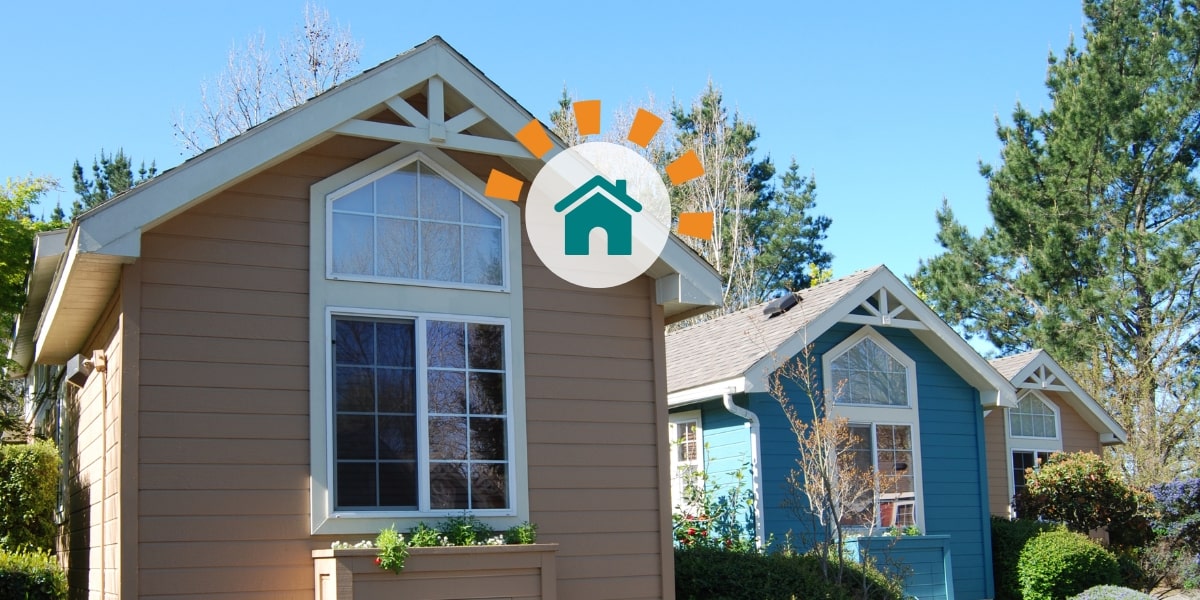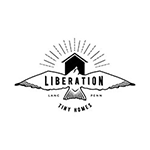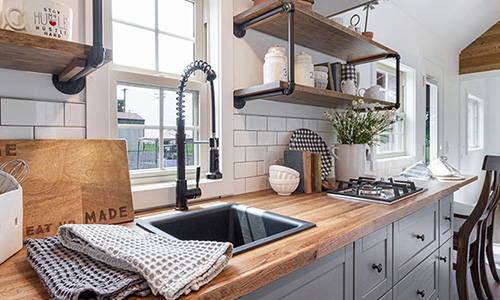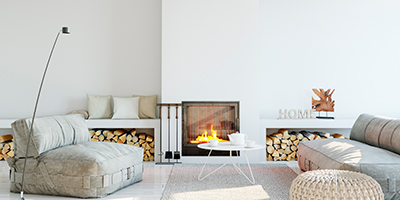The Beginner's Guide to Tiny House Living
From shipping container homes to converted school buses — here's how to make your tiny dreams come true.
Make cleanup a breeze with a roll off dumpster:

The Big Question: Are Tiny Homes Worth it?
If you decide to downsize to a tiny home, you aren’t just committing to a house to reside in, it’s a completely new lifestyle. With the help of Marcus Stoltzfus of Liberation Tiny Homes, we’ll share everything you need to know while considering the freedom of minimalism.
Tiny Home Lifestyle FAQs
Is a tiny house a good investment?
Unfortunately, most financial advisors would answer no. Buying or building a tiny home is typically not viewed as a long-term investment strategy. But don't let that scare you away if living small is your calling — you can't put a price on happiness.
How long do tiny houses last?
Generally, tiny homes can last between 7-10 years. This can range significantly based on the building materials and regular maintenance. It's important to work with a professional, experienced builder to make sure your home is structurally sound for the long haul.
Is it cheaper to buy or build a tiny house?
It's usually cheaper to build your own tiny house than it is to purchase a prefabricated model. However, the extra cost of working with a professional builder is often worth it. Building a tiny home is a big project, and it's easy to underestimate the job — one small mistake can add unexpected costs and take a lot of extra time to repair.
Can you permanently live in a tiny home?
Yes, it's possible to live in a tiny house long-term. This can save money over time and help minimize your carbon footprint. However, if you want your tiny home to last, you'll need to make sure it's built with quality materials. If it's a traditional tiny home — not on wheels — you'll also need to build a solid foundation that meets building codes for it to be accepted as permanent housing.
What Is a Tiny House?
How big — or small — is a tiny house? They are typically 500 square feet or less in floor area, excluding lofts. To put that number into perspective, the typical American home is about 2,600 square feet on average, a 2,100-square-foot difference.
"There are plenty of definitions of what people think a tiny house is," Stoltzfus said. "For us, a tiny house is something under 500 square feet and has everything you need to live your life comfortably. It might even be on wheels and it certainly requires a minimalist lifestyle to live within it."
5 Popular Types of Tiny Houses
Tiny houses can come in many different shapes, sizes and styles ranging from repurposed shipping containers to charming little log cabins.
Here are a few examples:
- Bus or van conversions
- Shipping containers
- Cob houses
- House on wheels
- Custom small homes

"We build anything from 12-40 feet long at the standard 8.5-foot width. Since we are a custom builder, we offer several starting points, but almost all of our clients customize their homes to fit their needs. Our homes all come on wheels and can be transported and lived in all around the country!"
Where Can You Put a Tiny Home?
An important decision to make early in the planning process is where your new residence will sit. If your little home is going to be stationary, these are a few options of places you can put down your new roots.
Consider one of these locations for your tiny home:
- A backyard: You can build your house in the backyard of someone looking to rent their land. Legally, this is called an “accessory dwelling unit.”
- Purchased land: This can be more expensive, but purchasing land is a good solution if you plan on keeping your house in a permanent location.
- Rented land: Land to rent is more difficult to find, but gives you the option of opting out if you want to move in the future.
- A tiny house community: Each community has different rules, but it’s a great opportunity to live around like-minded people.
Some local codes will recommend getting your RVIA (Recreational Vehicle Industry Association) certification which means your house must be built by a certified company. Having your RVIA certification makes financing, insurance and parking in RV-only parks easier. Some home builders are not RVIA certified because they consider their homes to be permanent residences and not an RV.

"Where can you live in your tiny house? The simple answer is: it depends on where you place it. Each county, township and state will view it differently. More states on the west coast are accepting than on the east coast, but legal spots are increasing.”
Is the Tiny Home Lifestyle a Good Fit for You?
There are a variety of reasons why people choose to downsize and go for the minimalist lifestyle, and just as many factors to reflect on before jumping in. There’s a lot more to consider than just the idea of living in a functional, small home.
5 Tiny House Benefits
- Lower monthly expenses: For most Americans, one-third to one-half of their income is dedicated to their mortgage and home expenses. For many tiny homeowners, their monthly expenses can range from $150 - $600. For the average American middle-class homeowner, monthly expenses are around $1,784. The monthly cost of the average home is much more than just your utilities, insurance, taxes and mortgage, but also repairs and maintenance based on the age of your home and the surrounding climate.
- Minor energy use: Your tiny home may be small, but it’s big on energy efficiency. On average, they use 7% of a traditional home’s energy. From solar energy roof panels to LED lightbulbs, small modifications can make your tiny home even more efficient.
- Off-grid capabilities: Since many tiny houses are built on wheels, you have the added benefit of mobility. Using gas or solar generators, you can easily go off-grid and be able to generate power no matter where you are.
- Minimalist lifestyle: This idea means living with less and using what you have to the maximum ability. It can be very freeing to some and allow for a lot more opportunities to travel.
- The tiny house community: Various Facebook groups and meetups exist where you can network and bond with other small homeowners.
3 Disadvantages of Tiny Home Living
- Build Restrictions: Each state has its own regulations on tiny homes. Whether your home is grounded or mobile, you’ll have to do your research to make sure your home complies with local rules. It’s a good idea to review Appendix Q before sitting down to decide on your floorplan and where you will reside.
- No Permanent Address: If you purchase the land your tiny home is on, that will be your permanent address. However, if you’re traveling often, you might consider a P.O. Box in your home state, which may require help from friends or family to collect important mail.
- Lower Potential for Resale: Some real estate experts say that tiny houses are part of a niche market, making them harder to resell and risky investments. If your home is custom-built, your preferences may not be appealing to everyone.

4 Tiny House Living Tips: Downsize and Simplify
If you’re really considering downsizing to a tiny house, whether you’re looking for a new adventure or more financial freedom, here are four tips to determine if it’s a good fit for you and how to get started.
Tip 1: Do a Test Run
Before you fully commit, check Airbnb or Vrbo to rent a tiny house for a weekend to see how it feels. Even though the home won’t be customized to your exact style, you’ll get an idea if you could call your small house a home.
"Before you dive in, do plenty of research," Stoltzfus said. "Check out the various homes. Try them out on Airbnb. Get to know the different builders. Ask yourself what rooms you spend the most time in during the day. Are you a cook? Then the kitchen will be a big focus for you. Are you a gamer? Then the living area should have enough space for a game system and a big screen."
Tip 2: Declutter Belongings
Once you’ve decided to make the commitment, it’s time to cut down your possessions and find creative ways to organize what’s left. Start by taking inventory of what to get rid of before your move by making lists of things you must have, can live without and can replace. It’s safe to estimate you’ll need to purge about 75 percent of your belongings during the shift to a tiny life.
Some items you can eliminate right away are:
- Rarely used kitchen appliances or duplicate items.
- Oversized televisions.
- Expired or half-used bathroom products.
- DVDs, video games and CDs.
- Clothing and shoes you no longer wear.
- Bulky furniture.
- Decorative trinkets or knick-knacks.
Once you get rid of these items, you may feel lighter and be able to picture your new lifestyle more clearly.
Tip 3: Create a Floorplan
You’ll need to plan for the logistics and functionality of your tiny home. It’s a good idea to think of ways to make things cross-functional. Think about what components are important to you and your lifestyle.
- Do you absolutely love cooking? Consider full-size appliances in your kitchen.
- Do you plan on having guests stay over? Make sure to have a hideaway Murphy bed or foldaway couch.
- Will you need extra storage? Design a loft space with additional storage under your stairs and around your bed in your loft.
- Are you big on open space? Opt for fewer walls in your home for a more multipurpose space, such as your kitchen table becoming your computer desk. For privacy when needed, you can add sliding barn or pocket doors.
Working with a tiny home manufacturer will help immensely to make sure you can customize your house to your needs.

"Pick your builder wisely. A more established builder has already gone through all of the issues that usually creep up at the beginning of a tiny house business. First-timers that build your home might not realize certain things that a builder who has built dozens already knows. It makes a big difference.”
Tip 4: Budget for Your Tiny House
Tiny house living offers considerable savings and inherently means less clutter, which can be a win-win for many people. You still must be careful, though. A tiny house, as with any home, can quickly become a money pit.
Costs of Living Small
Expense | What to Consider |
|---|---|
Tiny house | The cost of your actual house can range from a $10,000 DIY kit to $50,000 or more for a custom-built home. |
Mortgage | Banks normally will not finance a tiny home, so many choose to pay for their house upfront. You will most likely need to look into a personal loan or RV loan for a financing option. |
Homeowners' insurance | Depending on the type of insurance, your home’s size and its value, yearly costs can range from $650-$1,200. |
Utilities | Some utilities can be included in where you choose to park, such as water, trash or electric. Your home is likely to be very efficient, so you should budget for about $120 to $200 a month. |
Rent or parking fees | This can range from as low as $120 to $500 per month. |
Gas and towing | If your home is mobile, consider the costs of maintenance for the vehicle and towing your home, along with expenses for a hitch, trailer and gas. |
Scale Down: Planning for Your New Lifestyle
While television and Pinterest might make the tiny house lifestyle seem incredibly appealing, it isn’t for everyone. Becoming an extreme minimalist may take a lot of work and adjustment, but if you’ve weighed all the pros and cons and are passionate about the philosophy of “less is more,” it could be a perfect fit.
If you’re ready to pack it up and take the tiny house plunge, here’s our decluttering guide to help you purge each room of your home to live simply.
Expert Contributor

Marcus Stoltzfus
Marcus manages human resources at Liberation Tiny Homes in Lancaster, PA. He is part of a creative team of craftsmen who design and construct custom homes so you can have the ideal small space for you. The company's website brings tiny house stories, inspiration and expert insights to the tiny living community nationwide.
What Do You Think?
Do you dream of living small? We're listening. Head over to Twitter or Facebook,
and use #dumpstersblog to join the conversation.


